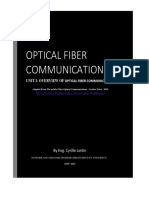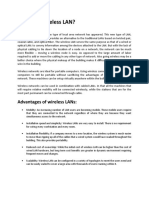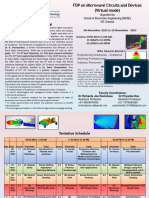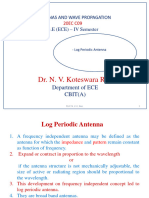Optical Fibre Communication Versus Wireless
Optical Fibre Communication Versus Wireless
Uploaded by
ritikshanuCopyright:
Available Formats
Optical Fibre Communication Versus Wireless
Optical Fibre Communication Versus Wireless
Uploaded by
ritikshanuOriginal Title
Copyright
Available Formats
Share this document
Did you find this document useful?
Is this content inappropriate?
Copyright:
Available Formats
Optical Fibre Communication Versus Wireless
Optical Fibre Communication Versus Wireless
Uploaded by
ritikshanuCopyright:
Available Formats
International Journal Of Multidisciplinary Research In Science, Engineering and Technology (IJMRSET)
| ISSN: 2582-7219 | www.ijmrset.com | Impact Factor: 4.988
| Volume 4, Issue 4, April 2021 |
Optical Fibre Communication versus Wireless
Communication
Akanksha Singh
Assistant Professor, Department of Electronics and Communication Engineering, Khwaja Moinuddin Chishti Language
University, Lucknow, Uttar Pradesh, India
ABSTRACT: Optical fiber which are long, thin, made with pure glass about the diameter of human hair and it is a
dielectric waveguide or medium in which information (voice, data or video) is transmitted through a glass or plastic
fiber, in a form of light. -Optical fiber communication system consists of three basic elements:- 1) the optical
transmitter 2) optical fiber cable 3) the optical receiver. Jacques Babinet> < John Tyndall included a demonstration of it
in his public lectures in London, 12 years later. Tyndall also wrote about the property of total internal reflection in an
introductory book about the nature of light in 1870. Multimode fiber :-If the diameter of the core of the fiber is large
enough so that there are many paths that light can take through the fiber, the fiber is called "multimode" fiber. 2) Single
mode fiber :-Single- mode fiber has a much smaller core that only allows light rays to travel along one mode inside the
fiber, the fiber is called ‘’single mode’’ fiber. Advantages 1) Enormous bandwidth 2) Low transmission loss 3)
Immunity to cross talk 4) Electrical isolation 5) Signal security 6) Flexibility 7) Reliability 8) Ease of installation 1)
High cost and most expensive 2) Fragility 3) Affected by chemicals 4) Opaqueness (exposed to radiation) 5) Scattering
I. INTRODUCTION
Wireless and optical communication differ in many ways, but perhaps the key differentiator between fixed wireless
links and optical communications systems is in the bandwidth. Fiber optic cables are almost capable of supporting
unlimited bandwidth, which translates to Gb/sec data rates. Fixed wireless links (and all wireless systems), since they
are sending signals through free space rather than through an optical fiber or other confined medium, operate within
fixed segments of frequency spectrum that must be licensed for different applications to avoid interference from too
many signals within the same frequency range in the same location. As a result, the limited bandwidth of any wireless
system will also limit the amount of data that can be transferred between points at any one time.
The bandwidth of an optical fiber is potentially as wide as the optical portion of the electromagnetic (EM) spectrum, or
about 10 THz or more. Of course, to harness such bandwidth, a transmitter and receiver are needed at both ends of a
link.[1]
FIG.1
IJMRSET © 2021 DOI:10.15680/IJMRSET.2021.0404011 547
International Journal Of Multidisciplinary Research In Science, Engineering and Technology (IJMRSET)
| ISSN: 2582-7219 | www.ijmrset.com | Impact Factor: 4.988
| Volume 4, Issue 4, April 2021 |
Wireless communications systems are licensed for their use of frequency bandwidth to avoid congestion within one
band Because they send signals through free space rather than through a “captive” propagation medium such as an
optical cable. (FIG.1)
Similar to the way that frequency bandwidths are divided in wireless systems using frequency division multiplex
(FDM), optical communications systems use forms of wavelength division multiplexing (WDM) to increase capacity
over optical fiber lines by using different wavelengths through the cable for different carriers. By multiplexing or
combining different carriers at the optical transmitter and demultiplexing or extracting the separate carriers at the
optical receiver, the data rate of a single fiber line can be dramatically increased into the Tb/s range.[2]
FIG.2
Just as some optical energy is lost as a function of distance through an optical cable, some EM energy is lost by
microwave signals propagating through the atmosphere, with loss increasing as a function of distance and increasing
frequency. As a result, while bandwidth is available for wireless communications at millimeter-wave frequencies and
even as high as THz frequencies, the practical range of any wireless communications system based on such high
frequencies will be limited, with THz communications limited to the near fields of the antennas, essentially within the
same room.[3]
Fiber-optic networks have a key advantage over wireless communications technology: they are immune to the effects
of electromagnetic interference (EMI). EMI is often present in an enclosed space like an office building, caused by
multiple RF sources and signal leakage and reflections, and can wreak havoc on wireless communications. For that
reason, and because of the difficulty of “eavesdropping” on a fiber-optic network, optical communications systems are
often used as the communications backbone for surveillance systems in buildings. For the difficulty of installing a
fiber-optic network, it has its rewards of amazing bandwidth and robustness (FIG.2)
II. DISCUSSION
The steps describe the data flow through optical communication system.
• Step-1: The information (voice, video, data) to be transmitted will be converted into the form compliant to medium.
Appropriate coder or converter is used for this purpose which converts analog signals into digital pulses. A/D converter
can be used for this. The computer data can already be in the digital form.
• Step-2: The optical transmitter device (such as LED ) is used to flash light source ON and OFF based on digital
pulses. Infrared beams are also used in the transmission of information. The other optical transmitter device is solid
state laser.
• Step-3: The light beams are fed appropriately into fiber optic cable so that it can be transmitted over long distances.
• Step-4: At the receiving end, optical receiver devices such as photocell or light detector is used to detect light pulses.
This devices convert electrical pulses into electrical signal. Amplifier is used to amplify and reshape the signal back to
digital form.
• Step-5: The digital pulses are fed to decoder which coverts digital pulses into voice/video form. D/A converter is used
for this purpose.• To support long distances optical repeaters are used along the path of fiber optic chain.
IJMRSET © 2021 DOI:10.15680/IJMRSET.2021.0404011 548
International Journal Of Multidisciplinary Research In Science, Engineering and Technology (IJMRSET)
| ISSN: 2582-7219 | www.ijmrset.com | Impact Factor: 4.988
| Volume 4, Issue 4, April 2021 |
However, the type of communication which uses Electro-Magnetic waves as medium of communication is known as
wireless communication. It uses different frequency bands based on distance coverage and terrain requirements.
Various types of modulation schemes are used which helps in achieving different bandwidth/data rate.[4]
There are different types of wireless communication which include satellite communication, microwave line of sight
communication, cellular communication (GSM, CDMA, LTE etc.), short range wireless communication (WLAN,
Bluetooth, Zigbee, Zwave, LoRaWAN etc.).
III. SOME NEW DISCOVERIES
first_page
Underwater Optical Wireless Communication (UOWC) is not a new idea, but it has recently attracted renewed interest
since seawater presents a reduced absorption window for blue-green light. Due to its higher bandwidth, underwater
optical wireless communications can support higher data rates at low latency levels compared to acoustic and RF
counterparts. The paper is aimed at those who want to undertake studies on UOWC.
FIG.3
It offers an overview on the current technologies and those potentially available soon. Particular attention has been
given to offering a recent bibliography, especially on the use of single-photon receivers.(FIG.3,4)
FIG.4
IV. CONCLUSION
Communications have relied on signals propagating through the air from the earliest drumbeats. Wireless
communications technologies make effective use of that signal transport medium even as the appetite for more and
IJMRSET © 2021 DOI:10.15680/IJMRSET.2021.0404011 549
International Journal Of Multidisciplinary Research In Science, Engineering and Technology (IJMRSET)
| ISSN: 2582-7219 | www.ijmrset.com | Impact Factor: 4.988
| Volume 4, Issue 4, April 2021 |
faster voice, video, and data grows. Still, light has been another long-time form of communications, literally “as far as
the eye could see,” and optical communications has advanced at a pace equal to or exceeding the evolution of wireless
communications. The technologies are much different, but each has its place, its strengths, and its weaknesses. Wireless
communications relies on the transmission and reception of RF/microwave signals modulated with the information to
be carried while optical communications uses modulated light beamed through fiber-optic cables. For a fair comparison
of the technologies, fixed wireless systems will be compared to optical communications systems because of the lack of
mobility for optical links.(FIG.5)
1.
FIG.5
In the case of fixed wireless communications, the infrastructure is installed in discrete locations, with line-of-sight
(LOS) paths between the locations so that radio waves can propagate through the atmosphere without obstructions. The
extreme example of a long LOS wireless link is a satellite, with a clear path between an earth station and the satellite
orbiting Earth. A more typical example is the collection of cellular communications antennas and their towers found on
hills or high points in the terrain, often along roadways. Wireless communications infrastructure can be found in these
single locations, and readily accessed for maintenance. Signals from multiple individual fixed wireless links are routed
through relay stations that join multiple connected wireless links for nearly instantaneous wireless communications
across long distances.
The infrastructure of an optical communications system, on the other hand, is distributed from one communications
location to another. Fiber-optic cables must be installed from one point to the next to enable optical communications.
The quality of those cables is important to the performance of an optical communications system, as is the integrity of
the splices between sections of optical cable. Whereas a fixed microwave link sends information through the air
between two points, a fiber-optic link depends upon these cables, which must be installed with care and then
maintained over time, since they can deteriorate and wear out. Optical cables can break or be cut and must be repaired,
but first the fault must be found, often in many miles of optical cable, and this is not a trivial task. Business models for
laying fiber-optic cables typically assume a 50-year lifespan for the capital investment of installing the optical network
equipment, which may also include links to individual subscribers, known as fiber-to-the-hole (FTTH) optical
communications.[5]
Although the speed of light through a vacuum is well known (186,000 miles/s), light slows down when it is not in a
vacuum (such as outer space). It can slow down significantly when it travels through a medium such as the glass or
plastic fibers used in optical cables. While fixed wireless systems are designed for LOS links between transmitter and
IJMRSET © 2021 DOI:10.15680/IJMRSET.2021.0404011 550
International Journal Of Multidisciplinary Research In Science, Engineering and Technology (IJMRSET)
| ISSN: 2582-7219 | www.ijmrset.com | Impact Factor: 4.988
| Volume 4, Issue 4, April 2021 |
receiver, optical communications systems typically do not have the luxury of a straight path and must often wind
around corners through a city or in an office building for their signal paths. As with light reflecting off walls around a
corner, every bend in the cable decreases the speed of the light propagating through that cable.
As a result, in terms of pure communications speed, fixed wireless links typically provide faster connections than
optical links. The connection speed is usually measured in terms of a system’s latency, which is essentially the time
required to receive and respond to a signal. It takes into account signal switching and any delays through the
propagation medium. The latency of a fiber-optic system is typically longer than that of a fixed wireless link for the
same distance, and increases significantly with increases in link distance compared to a fixed wireless link.
Perhaps the key differentiator between fixed wireless links and optical communications systems is in bandwidth. Fiber-
optic cables are capable of supporting almost unlimited bandwidth, which translates to Gb/s data rates. Fixed wireless
links (and all wireless systems), since they are sending signals through free space rather than through an optical fiber or
other confined medium, operate within fixed segments of frequency spectrum that must be licensed for different
applications to avoid interference from too many signals within the same frequency range in the same location. As a
result, the limited bandwidth of any wireless system will also limit the amount of data that can be transferred between
points at any one time.
The bandwidth of an optical fiber is potentially as wide as the optical portion of the electromagnetic (EM) spectrum, or
about 10 THz or more. Of course, to take advantage of such bandwidth, a transmitter and receiver are needed at both
ends of a link. While the components for an optical transmitter, such as a light-emitting diode (LED) or laser
transmitter, and a photodiode-based receiver are fairly common and low in cost, the data speeds of systems using these
components is still limited to the low Gb/s range rather than the Tb/s range.[6]
Because of the enormous bandwidth available using fiber-optic cables, they are often used to route signals from fixed
and mobile wireless base stations to their carrier’s signal switching stations for making interconnections to customers.
Fiber-optic cables have replaced metal cables in many fixed communications installations, such as in warehouses and
office buildings, and serve as communications backbones in many types of wireless communications systems,
including in base stations for the latest 4G LTE mobile wireless communications systems. Likely, optical
communications links will serve similar functions in emerging 5G mobile wireless communications systems.
Similar to the way that frequency bandwidths are divided in wireless systems using frequency division multiplex
(FDM), optical communications systems use forms of wavelength division multiplexing (WDM) to increase capacity
over optical fiber lines by using different wavelengths through the cable for different carriers. By multiplexing or
combining different carriers at the optical transmitter and demultiplexing or extracting the separate carriers at the
optical receiver, the data rate of a single fiber line can be dramatically increased into the Tb/s range. The two chief
WDM methods currently in use in optical communications systems are dense WDM (DWDM) and coarse WDM
(CWDM), which has less wavelength channels with wider spacing than DWDM. The result is lower data rates, but
CWDM systems can be implemented with lower-cost components without the need for the stability and precision
required by the closely spaced carriers in DWDM optical communications systems.[7]
REFERENCES
1. Pang G, Ho KL, Kwan T, Yang E. 1999 Visible light communication for audio systems. IEEE Trans. Consum.
Electron. 45, 1112–1116. (doi:10.1109/30.809190)
2. Tanaka Y, Haruyama S, Nakagawa M. 2000 Wireless optical transmissions with white colored LED for wireless
home links. In Proc. IEEE Int. Symp. on Personal Indoor and Mobile Radio Communications (PIMRC) vol. 2, London,
UK, 18–21 September 2000, pp. 1325–1329. IEEE.
3. Danakis C, Afgani M, Povey G, Underwood I, Haas H. 2012 Using a CMOS camera sensor for visible light
communication. In Proc. IEEE Globecom Workshops, Anaheim, CA, 3–12 December 2012, pp. 1244–1248. IEEE.
IJMRSET © 2021 DOI:10.15680/IJMRSET.2021.0404011 551
International Journal Of Multidisciplinary Research In Science, Engineering and Technology (IJMRSET)
| ISSN: 2582-7219 | www.ijmrset.com | Impact Factor: 4.988
| Volume 4, Issue 4, April 2021 |
4. Roberts RD. 2013 Space-time forward error correction for dimmable undersampled frequency shift ON-OFF keying
camera communications (CamCom). In Int. Conf. on Ubiquitous and Future Networks, ICUFN, Da Nang, Vietnam, 2–
5 July 2013, pp. 459–464. IEEE.
5. Liu W, Xu Z. 2020 Some practical constraints and solutions for optical camera communication. Phil. Trans. R. Soc.
A 378, 20190191. (doi:10.1098/rsta.2019.0191)
6. Little TDC, Dib P, Shah K, Barraford N, Gallagher B. 2008 Using LED lighting for ubiquitous indoor wireless
networking. In Proc. - 4th IEEE Int. Conf. on Wireless and Mobile Computing, Networking and Communication,
WiMob 2008, Dalian, China, 19–21 September 2008, pp. 373–378. IEEE.
7. O’Brien DC, Zeng L, Le-Minh H, Faulkner G, Walewski JW, Randel S. 2008 Visible light communications:
challenges and possibilities. In IEEE 19th Int. Symp. on Personal, Indoor and Mobile Radio Communications, Cannes,
France, 15–18 September 2008, pp. 1–5. IEEE.
IJMRSET © 2021 DOI:10.15680/IJMRSET.2021.0404011 552
You might also like
- 5G Interview Question and AnswerDocument11 pages5G Interview Question and Answeraslam_326580186100% (1)
- Introduction To Ultra-Wideband Radar SystemsDocument683 pagesIntroduction To Ultra-Wideband Radar Systemssudantha.pereraNo ratings yet
- CYF121S F221S ManualDocument21 pagesCYF121S F221S ManualMikeNo ratings yet
- PCTEL RF Solutions Presentation Scanner MX EXf IBfDocument35 pagesPCTEL RF Solutions Presentation Scanner MX EXf IBfShashank Prajapati100% (1)
- Optical Communication Systems-Yahia AMIREHDocument5 pagesOptical Communication Systems-Yahia AMIREHKal AbayNo ratings yet
- 12 I January 2024Document13 pages12 I January 2024Carlin MendozaNo ratings yet
- WCE2014 pp438-442Document5 pagesWCE2014 pp438-442Bilal HassanNo ratings yet
- IntroductionDocument7 pagesIntroductionradjah.abderraoufNo ratings yet
- Optics 2Document4 pagesOptics 2Antush TesfayeNo ratings yet
- BiniyamDocument8 pagesBiniyamnafntitesfayeNo ratings yet
- A Detailed Discussion of Free Space Optical Communication Systems A ReviewDocument14 pagesA Detailed Discussion of Free Space Optical Communication Systems A ReviewEditor IJTSRDNo ratings yet
- The Most Common Uses of Fiber Optic Cables: Data Communications تﻻﺎﺼﺗاDocument7 pagesThe Most Common Uses of Fiber Optic Cables: Data Communications تﻻﺎﺼﺗاljjbNo ratings yet
- Core NWDocument244 pagesCore NWprodigynaveenNo ratings yet
- Seminar ReportDocument12 pagesSeminar ReportNupurNo ratings yet
- Lecture 01 Fiber OpticsDocument32 pagesLecture 01 Fiber OpticsadilimediriNo ratings yet
- Design and Fabrication of A Micro-Strip Antenna For Wi-Max ApplicationsDocument54 pagesDesign and Fabrication of A Micro-Strip Antenna For Wi-Max ApplicationsaylokolloNo ratings yet
- Optical Fiber AdvantagesDocument7 pagesOptical Fiber AdvantagesSANTOSH THE DONNo ratings yet
- Optical CommunicationDocument25 pagesOptical CommunicationKlNo ratings yet
- UNIT 8 - NetworksDocument15 pagesUNIT 8 - NetworksChrispin MachilikaNo ratings yet
- OWC-notes-M1-M2Document83 pagesOWC-notes-M1-M2Anu SNo ratings yet
- 9080 rEVY5PCDocument15 pages9080 rEVY5PCNagabhushanaNo ratings yet
- Advantages of Optical Fiber CommunicationDocument7 pagesAdvantages of Optical Fiber Communicationmohammadanas7686No ratings yet
- IT Professional AssignmentDocument29 pagesIT Professional AssignmentMikiale kirosNo ratings yet
- PROT2 1-3 Teleprot Anexo 1Document35 pagesPROT2 1-3 Teleprot Anexo 1Fernando MendesNo ratings yet
- Free Space Optical Communications - Theory and Practices: Abdulsalam Ghalib Alkholidi and Khaleel Saeed AltowijDocument54 pagesFree Space Optical Communications - Theory and Practices: Abdulsalam Ghalib Alkholidi and Khaleel Saeed AltowijUmair AhmedNo ratings yet
- Future Trends in Fiber Optics Communication: Francis Idachaba, Dike U. Ike, and Orovwode HopeDocument5 pagesFuture Trends in Fiber Optics Communication: Francis Idachaba, Dike U. Ike, and Orovwode HopeHelloNo ratings yet
- Optical Fiber ThesisDocument79 pagesOptical Fiber ThesisHashmat MohamadNo ratings yet
- 1 Transmission: 1.1 Optical Fiber CommunicationDocument18 pages1 Transmission: 1.1 Optical Fiber CommunicationMuraliKrishnaNo ratings yet
- E1-E2 - Text - Chapter 15. OVERVIEW OF OPTICAL COMMUNICATIONDocument18 pagesE1-E2 - Text - Chapter 15. OVERVIEW OF OPTICAL COMMUNICATIONabhimirachi7077No ratings yet
- Application OF Fibre Optics in CommunicationDocument14 pagesApplication OF Fibre Optics in CommunicationNaman TyagiNo ratings yet
- Fibre Optic Transmission LinkDocument3 pagesFibre Optic Transmission Linknotkowsik007No ratings yet
- Future Trends in Fiber Optics CommunicationDocument6 pagesFuture Trends in Fiber Optics CommunicationKoustav MondalNo ratings yet
- Group 7 Communication NetworkDocument27 pagesGroup 7 Communication Networkreginald tannorNo ratings yet
- Network 6Document3 pagesNetwork 6funmastiNo ratings yet
- Fibre Optics CommunicationDocument21 pagesFibre Optics CommunicationJoshua DuffyNo ratings yet
- Future Trends in Fiber Optics CommunicationDocument6 pagesFuture Trends in Fiber Optics CommunicationSupri GunNo ratings yet
- E5-E6 - Text - Chapter 5. Overview Oftransmission TechnologyDocument54 pagesE5-E6 - Text - Chapter 5. Overview Oftransmission Technologysumit15sksNo ratings yet
- Fiber Optical Final - Unit 1-2Document45 pagesFiber Optical Final - Unit 1-2MALOBE LOTTIN CYRILLE MARCELNo ratings yet
- Module 1 - OCNDocument19 pagesModule 1 - OCNNaveen KumarNo ratings yet
- Introduction To Fiber OpticsDocument9 pagesIntroduction To Fiber Opticsnares82821No ratings yet
- ADCDocument13 pagesADCGhazanfar RehmanNo ratings yet
- FOC MATERIAL FinalDocument16 pagesFOC MATERIAL FinalDeepesh KushwahaNo ratings yet
- Electronics Communication - Engineering - Optical Fiber Communication - Overview of Optical Fiber Communication - Notes PDFDocument36 pagesElectronics Communication - Engineering - Optical Fiber Communication - Overview of Optical Fiber Communication - Notes PDFSukhada Deshpande.No ratings yet
- Power Grid Corporation of India Limited - Summer Training REPORT (Slide)Document47 pagesPower Grid Corporation of India Limited - Summer Training REPORT (Slide)Deepak Mehra40% (5)
- Networking ConceptsDocument58 pagesNetworking ConceptsDeepika KaurNo ratings yet
- Report SampleDocument9 pagesReport Samplenicknick3483485No ratings yet
- Optical and Wireless Communication_compressed (1)Document166 pagesOptical and Wireless Communication_compressed (1)Sandeep Y GNo ratings yet
- Physics ProjectDocument30 pagesPhysics ProjectRatik Bhatt76% (17)
- Physics Project: Manish YadavDocument30 pagesPhysics Project: Manish YadavManish Yadav100% (1)
- Optical FibresDocument29 pagesOptical Fibresnikhil67% (3)
- All About Optical FiberDocument40 pagesAll About Optical FiberanadiguptaNo ratings yet
- 13 - Microwave PhotonicsDocument8 pages13 - Microwave PhotonicsPedro SgNo ratings yet
- Report About Optical Fiber CommunicationDocument13 pagesReport About Optical Fiber CommunicationALI100% (1)
- Technical Report 1Document13 pagesTechnical Report 1Christian GarciaNo ratings yet
- Fiber-Optic Communication Is A Method of Transmitting InformationDocument19 pagesFiber-Optic Communication Is A Method of Transmitting Informationpy thonNo ratings yet
- Signal Transmission Using Optical FibreDocument21 pagesSignal Transmission Using Optical FibreVanam SaikumarNo ratings yet
- Fiber-Optic Communication - WikipediaDocument120 pagesFiber-Optic Communication - Wikipediajayakumar390jNo ratings yet
- High-Speed Optical Wireless Communication System For Indoor ApplicationsDocument3 pagesHigh-Speed Optical Wireless Communication System For Indoor ApplicationsAnkesh Kumar SrivastavaNo ratings yet
- Report??Document17 pagesReport??nicknick3483485No ratings yet
- To Study The Optical Fibers & It's Applications - Physics Investigatory ProjectsDocument46 pagesTo Study The Optical Fibers & It's Applications - Physics Investigatory Projectsgokulrajasekaran2007No ratings yet
- Full-Duplex Communications for Future Wireless NetworksFrom EverandFull-Duplex Communications for Future Wireless NetworksHirley AlvesNo ratings yet
- Meditation On Candle LightDocument1 pageMeditation On Candle LightritikshanuNo ratings yet
- SGS-3B-Applications of Fundamental RightsDocument11 pagesSGS-3B-Applications of Fundamental RightsritikshanuNo ratings yet
- Design and Study of A Fiber Optic Digital Link: Nidhi SharmaDocument6 pagesDesign and Study of A Fiber Optic Digital Link: Nidhi SharmaritikshanuNo ratings yet
- Equity-Research-Summer-Project Mumbai UniversityDocument67 pagesEquity-Research-Summer-Project Mumbai UniversityritikshanuNo ratings yet
- Ritika SecuritiesDocument61 pagesRitika SecuritiesritikshanuNo ratings yet
- Philips HC300 12178Document10 pagesPhilips HC300 12178shenkee-1No ratings yet
- CT NotesDocument227 pagesCT NotesAnonymous ODLmPN5g100% (3)
- Meyers CompTIA 4e PPT Ch15Document105 pagesMeyers CompTIA 4e PPT Ch15ali_bohahaNo ratings yet
- Bai Tap Mon HocDocument1 pageBai Tap Mon HocSang Phan ThanhNo ratings yet
- ATM To TE Mode Converter Designed With Semicircular Waveguide SectionsDocument4 pagesATM To TE Mode Converter Designed With Semicircular Waveguide SectionshosseinNo ratings yet
- Asset-V1 Wharton+ConnectedStrategy+2T2021+type@asset+block@Intro To Connected Strategy Module 4 SlidesDocument91 pagesAsset-V1 Wharton+ConnectedStrategy+2T2021+type@asset+block@Intro To Connected Strategy Module 4 SlidesdzugeekNo ratings yet
- 5G Overview SummaryDocument54 pages5G Overview SummarySUKUMAR GUCHHAITNo ratings yet
- Laboratory Manual: Analogue and Digital Communication LabDocument16 pagesLaboratory Manual: Analogue and Digital Communication LabData Communication&NetworkNo ratings yet
- 5G Unit Iii Question BankDocument9 pages5G Unit Iii Question BankramachandranriotNo ratings yet
- Duplexer Based On A Cavity Resonators For PSRDocument4 pagesDuplexer Based On A Cavity Resonators For PSRHuong tranNo ratings yet
- Resource Allocation Failure Service Degraded PDFDocument11 pagesResource Allocation Failure Service Degraded PDFyacine bouazniNo ratings yet
- Introduction To BluetoothDocument14 pagesIntroduction To Bluetoothamitt_54541529No ratings yet
- WIMAXDocument17 pagesWIMAXHareen KumarNo ratings yet
- 1 AP Lecture Notes PDFDocument248 pages1 AP Lecture Notes PDFramani senthil kumarNo ratings yet
- GU@5MHz Solution Deep DiveDocument29 pagesGU@5MHz Solution Deep DiveThanh PhongNo ratings yet
- What Is A Wireless Lan?: Advantages of Wireless LansDocument4 pagesWhat Is A Wireless Lan?: Advantages of Wireless Lansritu mandiya "student"No ratings yet
- Mobile Bluetooth Control CarDocument8 pagesMobile Bluetooth Control CarIJRASETPublicationsNo ratings yet
- Gmdss. Greece PiraeusDocument176 pagesGmdss. Greece Piraeussanya.suhihmail.ruNo ratings yet
- Sar Uav PDFDocument24 pagesSar Uav PDFadityaNo ratings yet
- FDP Brochure 1699237999Document3 pagesFDP Brochure 1699237999bt7pmhrx8wNo ratings yet
- Hybrid AIR DescriptionDocument32 pagesHybrid AIR DescriptionFlorian LoisonNo ratings yet
- DigiComm Tut 3Document4 pagesDigiComm Tut 3Js JsNo ratings yet
- Log Periodic AntennasDocument24 pagesLog Periodic AntennashrithikexamsNo ratings yet
- 3G-3.5 GDocument4 pages3G-3.5 GNyankoye Apollinaire LouaNo ratings yet
- Detection and Jamming Low Probability of Intercept RadarDocument123 pagesDetection and Jamming Low Probability of Intercept Radarknightatarms50% (2)





























































































